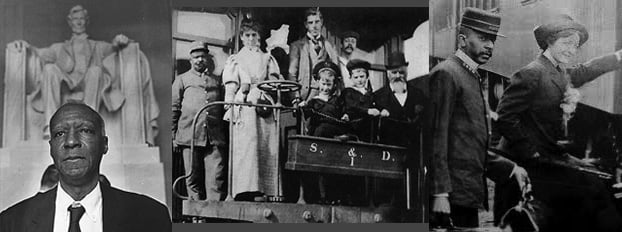
Pullman Porters: from Servitude to Civil Rights
It's the story of
what many people believe to be the first momentous step toward
the civil rights movement.
In 1867, Chicago industrialist George Pullman revolutionized rail
travel with his famous Pullman Cars.
When a Pullman Car was leased to a railroad, it came "equipped" with
highly-trained porters to serve the travelers. The cars were staffed
with recently freed slaves, whom Pullman judged to be skilled in
service and willing to work for low wages. Soon, The Pullman Rail
Car Company was the largest employer of blacks in the country,
with the greatest concentration of Pullman Porters living on Chicago's
South Side.
In their home neighborhoods, to be a Pullman Porter was considered
a prestigious position. The job offered a steady income, an opportunity
to travel across America, and a life largely free of heavy physical
labor, rare for blacks in that era. Historian Timuel Black recounts, "They
were good looking, clean and immaculate in their dress, their style
was quite manly, their language was very carefully crafted, so
that they had a sense of intelligence about them ... they were
good role models for young men."
 But
the porters were also mistreated, underpaid, overworked and subjected
to
countless indignities on the job. "A Pullman Porter was really kind of a
glorified hotel maid and bellhop in what Pullman called a hotel on wheels," explains
former porter and historian Greg LeRoy. "
The Pullman Company just thought of the porters as a piece of equipment,
just like another button on a panel - the same as a light switch
or a fan switch." Pullman demanded 400 hours a month or 11,000
miles - sometimes as much as 20 hours at a stretch -- and paid
ridiculously low wages (in 1926, an average of $810 per year --
about $7,500 in today's economy). "It didn't pay a livable
wage, but they made a living with the tips that they got, because
the salary was nothing, " says Lyn Hughes of the A.
Philip Randolph Pullman Porter Museum. The company expected
its employees to pay for their own meals, supply their own uniforms
and shoe polish, and allowed them only short naps on couches in
the smoking car. Disgruntled porters began to question their situation
and decided to take on the enormously powerful company.
But
the porters were also mistreated, underpaid, overworked and subjected
to
countless indignities on the job. "A Pullman Porter was really kind of a
glorified hotel maid and bellhop in what Pullman called a hotel on wheels," explains
former porter and historian Greg LeRoy. "
The Pullman Company just thought of the porters as a piece of equipment,
just like another button on a panel - the same as a light switch
or a fan switch." Pullman demanded 400 hours a month or 11,000
miles - sometimes as much as 20 hours at a stretch -- and paid
ridiculously low wages (in 1926, an average of $810 per year --
about $7,500 in today's economy). "It didn't pay a livable
wage, but they made a living with the tips that they got, because
the salary was nothing, " says Lyn Hughes of the A.
Philip Randolph Pullman Porter Museum. The company expected
its employees to pay for their own meals, supply their own uniforms
and shoe polish, and allowed them only short naps on couches in
the smoking car. Disgruntled porters began to question their situation
and decided to take on the enormously powerful company.
In 1925, the porters formed a union called The Brotherhood of Sleeping Car Porters.
This marked the beginning of a twelve-year struggle for dignity, better working
conditions, and fair pay. (Its leaders were charismatic black activist A. Philip
Randolph and former porter Milton Webster, head of the Chicago union local.)
Their eventual triumph marked the first time in American history that a black
union forced a powerful corporation to the negotiating table. It was a significant
step forward for black equality.
The union members learned how to organize and negotiate. They discovered that
even in a time of great prejudice in America, blacks could effect change if they
stood together and persevered. They would later apply these techniques to the
civil rights movement.
More
About the A. Philip Randolph Pullman Porter Museum Gallery
Located at 10406 S. Maryland Avenue in Chicago's Pullman Historic District, the
Museum Gallery was founded in 1995 by Lyn Hughes as the first African American
Labor History Museum in Chicago, in tribute to A. Philip Randolph, the Brotherhood
of Sleeping Car Porters and the African American Railroad attendants. The exhibit
features a collection of historical photos preserving and presenting moments
in time.
How
Sweet It Was-A Fond Memory
It seems that the Great One was a memorable passenger.
"One of the most remarkable stories I liked hearing about was how when Jackie
Gleason would ride ... all the porters wanted to be on that run. The reason why?
Not only because he gave every porter $100.00, but it was just the fun, the excitement,
the respect that he gave the porters. Instead of their names being George, he
called everybody by their first name. He always had like a piano in the car and
they sang and danced and had a great time. He was just a fun person to be around."
--Walter Biggs, son of a Pullman porter
Remembering
Mae
Dawson Hodges is a 99 year-old former Pullman porter who was interviewed for
the program. (He's pictured in action earlier on this page, holding a pair of
shoes.)
CHICAGO STORIES: Who were the customers on your train?
HODGES: Oh, some of everybody. Joan Crawford and different movie stars. I forget
the one movie star that gave me $10. She said "come up to see me." You
remember that movie star who said "my name is so-and-so, come up to see
me sometime." Well, I had her on the trains.
CHICAGO STORIES: Mae West. You remember her?
HODGES: She said, "My name is Mae West, come up to see me sometime." I
didn't pay that no mind. Long as I got the money.
Taking the A Train
"As the role of the Pullman porter began to be diminished in the forties
and the fifties, the culture and the racism of the south had not changed. And,
as an example, some people who traveled the south were often so angered by it
that they avoided it as much as they could -- the rejection in the same hotel
where you may have been the star in the front room [but] where you couldn't get
anything to eat or a place to sleep. Duke Ellington, as an example, rented or
purchased two [Pullman] cars for his orchestra. And when they would finish with
their assignment they would return to this to sleep and to eat and to practice.
They never felt that insult."--Timuel Black, historian
Behind
the Scenes
by program producer Lucy Kinsella
It's sad to see the personal stories from history die with the men and women
who were present at the time of the events. Finding former Pullman porters who
were alive when the union was created is difficult; they are a dying breed. We
were very lucky to find Mr. Hodges who turned 99 on Valentine's Day. He was delighted
to share his memories with us so that we could bring this story to you. You can
hear more personal stories of former porters, who have passed away, at the A.
Philip Randolph Pullman Porter Museum on Chicago's South Side.
One of the things I was shocked to learn was that Pullman porters were not paid
for morning hours. If a porter worked a run from 8 a.m. until 5 p.m., he was
only paid for the hours after noon. The porters were also required to arrive
at their trains hours before departure time in order to prep the train with towels,
linens, etc. The porters were not paid for these hours. On many occasions, they
were required to start a new run immediately following the end of another, given
no break in between and no time to see their families.
The Pullman Company was adept at pitting one race against another. The various
jobs at the Pullman Company were usually filled by one race. When the porters
decided to strike, the Pullman Company hired Filipinos as strike breakers. The
Pullman Company was sending the message, "You can and will be replaced."
Lucy Kinsella has produced many documentaries for A&E and the
History Channel, as well as independent projects as far away as
Tanzania and as close to home as Chicago's inner city.
Links
of Interest
Historic Pullman
Foundation
Architecture in the Pullman Historic District is unique as this community was
built in 1880-84 as a planned model industrial town by George M. Pullman.
More
About A. Philip Randolph
Biography, chronology, and more.
A. Philip Randolph Institute
Randolph and Bayard Rustin founded APRI in 1968 to continue the struggle for
social, political and economic justice for all working Americans.
Chicago Historical
Society
CHS has a collection of photos, audio tapes, and Pullman Company papers.
Newberry
Library
Newberry has the business papers from the Pullman Company, including employee
records, and files on the company's efforts to crush the Brotherhood of Sleeping
Car Porters. They also have a collection of photos.
Illinois Railway Museum
The museum has two Pullman cars, one built in 1910 and one built in 1925.

Your $40 Gift Membership will include:
|
























































